#Cyprinodontiformes
Text
Uncharismatic Fact of the Day
Calling the Anableps fishes “four-eyes” isn’t an insult-- these species actually have four eyes! Individuals have two eyeballs, and each eyeball has two pupils and two corneas. This allows the Anableps fishes to see above and below the water at the same time, and spot potential prey and predators twice as easily.
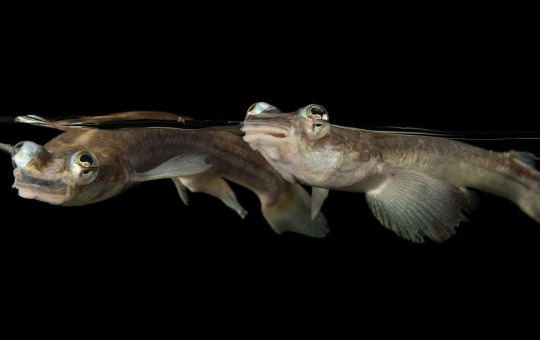
(Image: Largescale foureye fish (Anableps anableps) by Joel Sartore)
#largescale foureye fish#Cyprinodontiformes#Anablepidae#Ray-Finned Fish#Bony fish#fish#freshwater fauna#freshwater fish#wetlands#wetland fish#rivers#river fish#central america#south america#northern south america#Amazon Rainforest
2K notes
·
View notes
Text
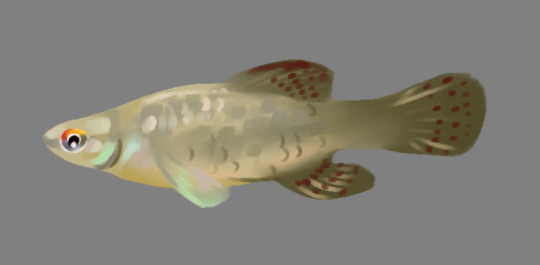
Aapticheilichthys websteri - No. 1
Starting off with a cutie! This killifish is found from Africa and lives in rivers.
46 notes
·
View notes
Text

Desert pupfish (Cyprinodon macularius)
By: William V. Ward
From: Natural History Magazine
1937
#desert pupfish#pupfish#cyprinodontiform#bony fish#fish#1937#1930s#William V. Ward#Natural History Magazine
209 notes
·
View notes
Text
Anyone here a killi person involved in killi clubs?
I need access to an article that's locked behind a membership to Killi-Data. I'm hoping to find someone that already has access so I don't have to join.
Here's the one I need:
Huber, J. H. 2019 (31 Aug.) A nomenclatural and systematic analysis of livebearing Cyprinodontiformes (Acanthopterygii: Anablepsinae, Goodeinae, Poeciliidae). Killi-Data Series 2019: 4-155.
[Link]
(All I actually need is the bit on the Poeciliidae.)
I am pretty sure it won't have any new information that I need for my science, but I need to confirm because it's listed on Catalog of Fishes as a relevant citation for taxonomy in one of my study species.
#fishblr#fish#killifish#killis#i know ive been mia here and one day i will update but today im just looking for assistance#the author is the person that runs the website so he wont share without a membership#but to be a member he wants tons of personal information and commitment#i really dont want to have all that added to their member database so people contact me#the fish im working on arent very flashy so they probably wont but i dont plan to stick with cyprinodontiformes#so i dont really want to open myself up to being contacted about them more than i would otherwise be just by publishing
10 notes
·
View notes
Text
trying to be a decent student but all I can think about is 1) fish in the order Cyprinodontiformes and 2) going to sleep
9 notes
·
View notes
Text
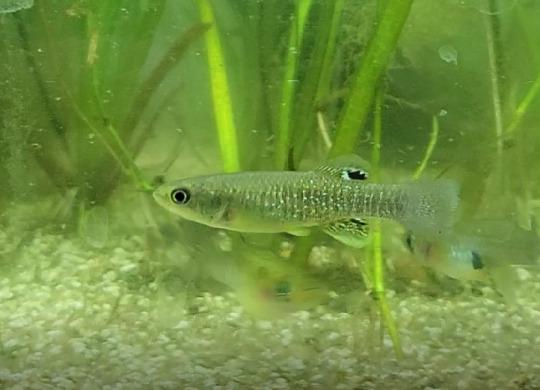
Surf’s Up! Coastal Topminnows for the Home Aquarium
So I’ll level with you - the North American Topminnows (Fundulidae) are a large family of fish, at least for the purposes of this page. There’s over 40 species in it and all are native to North America and there’s a wide range of temperaments, sizes, and water quality requirements. So what’s a Tumblr user to do? I’m going to split it up a bit into some nice edible chunks. Today I’ll be focusing on those species you can find along our Pacific and Atlantic Coasts.
Species
Fundulidae (Topminnows) is one of the 10 families in the order Cyprinodontiformes (Toothcarps) along with Poeciliidae (Livebearers), Cyprinodontidae (Pupfishes), Rivulidae (Rivulines, New World Killifish), and Aplocheilidae (Killifish). There are 3 genera; Fundulus with 39 species, Lucania with 3 species, and Leptolucania with a single species. Below are the species you are likely to find around the coasts of the U.S:
Fundulus confluentus - Marsh Killifish
Fundulus grandis - Gulf Killifish
Fundulus heteroclitus - Mummichog [pictured]
Fundulus jenkinsi - Saltmarsh Topminnow
Fundulus luciae - Spotfin Killifish
Fundulus majalis - Striped Killifish
Fundulus parvipinnis - California Killifish
Fundulus pulvereus - Bayou Killifish
Fundulus similis - Longnose Killifish
Fundulus xenicus - Diamond Killifish
Lucania parva - Rainwater Killifish
There are a few other species which, on weird or rare occasions may be found in the coast, especially where freshwater or brackish bodies of water empty into the ocean. The Banded Killifish (F. diaphanus) is one such case. But the above species are the ones you are more likely to find.
Finding these for sale in your typical aquarium store will probably be difficult. Very few of the Topminnows make it into the trade; the Diamond Killifish is probably the most common. Mummichogs are more sold as laboratory fish, but on very rare cases might be sold in stores. If you want one of the above fish, you will probably need to catch it yourself or special order online.
Conservation Status
Only one species in the above is considered Vulnerable by the IUCN, and that’s the Saltmarsh Topminnow. The rest are considered Least Concerned, overall. Do keep in mind that certain states may have their own designation; research and keep in mind before you do any collecting.
Distribution
In the northern Atlantic, you’re more likely to find Spotfin Killifish, Mummichogs, Striped Killifish, and Rainwater Killifish.
In the southern Atlantic, the local species are the Marsh Killifish, Striped Killifish, Mummichogs, Bayou Killifish, Longnose Killifish, and Rainwater Killifish.
In the gulf of Mexico, you can find the following species: Marsh Killifish, Gulf Killifish, Striped Killifish, Saltmarsh Topminnow, Bayou Killifish, Diamond Killifish, and Rainwater Killifish.
As implied by the name, the California Killifish is the only species found on the Pacific Coast.
Some of these species can be found inland as well, such as the California Killifish, Mummichog, and Gulf Killifish. Though they might make occasional forays into freshwater systems, you’re most likely to find them in brackish or salt water.
Description
Topminnows are, as a whole, elongated fish that usually stay small. At the lowest end are Rainwater and Diamond Killifish that are closest to 1.5 inches, while Striped and Gulf Killifish have been caught around 7 inches - females for both. Any of the above species are unlikely to exceed 3 or 4 inches if caught small and raised in an aquarium setting. Most of the above species are subdued in coloration; many have bars (faint or solid) and/or spots along the body. But a few are also a pretty solid silvery color. As with other Killifish, they do appear to have regional “variants” depending on where they are caught. The Mummichog shown was captured in Virginia.
Taken as a whole, Topminnows are more territorial than aggressive on average. They will push other fish out of their turf but don’t typically continue to chase tankmates once they have fled. Actual aggression does depend a bit, though, on the species. Diamond Killifish and Rainwater Killifish are very mellow and my experience with Mummichogs are that they are usually forgiving of other species. If you have the room, these species all do great given groups of conspecifics (Mummichog originally translates as “going in crowds”) - when found in the wild along a coastline, you can see them group together. But it also depends on tank size. In smaller tanks, a singleton is just fine.
Keep in mind there is a vast gulf between the easier and more difficult species to keep. Mummichogs are tough as rocks and can handle less than stellar conditions for long periods of time (not that you should submit them to this), while Rainwater Killifish and Striped Killifish adapt poorly to captive conditions and get easily banged up during transit. Reports seem to indicate most species are more on the difficult side, but I imagine this is partly a misunderstanding of required conditions, feeding habits, and tankmates, as Diamond Killifish are reported by some to be hard to keep - but a breeze by others.
Looking for native companions? Find yourself some peaceful or not-especially-boisterous fish from the same areas. Consider some of our coastal flatfish (like Achirus lineatus or Trinectes maculatus), smaller livebearers (Eastern Mosquitofish or Sailfin Mollies), our native Gobies (Gobiosoma bosc, Gobioides brousenetti), or maybe salt-tolerant Sticklebacks. You might be tempted to keep with Sheepshead Minnows, which also appear in the same range for many of these, but I would only do so in tanks 55 gallons or more (and only with larger species) because the Pupfish are much more pugnacious. The same can be said about our native Stegastes spp. Damselfish. And as always - keep in mind these fish are on the bottom of the food chain and they know it. They are an easy meal for medium-and-larger predatory fish, so keep them separate.
As the name implies, these fish mostly inhabit the top of the tank, searching for floating morsels to eat. They are great hiders if given some floating or tall decor - I personally like tall fake plants as our native seagrasses are delicate/finnicky (and oftentimes protected).
Feeding
For the few species I have tried, these fish seem to be very easy to feed. Dried Foods (flakes and pellets), frozen foods (brine shrimp, mysis shrimp, bloodworms, “marine” mixes), and live foods are all relished. They take to prepared foods right away - they push to be at the front of the chow line no matter what you feed. I’ve caught Mummichogs that began trusting me explicitly after the first offering of food.
A bit of an exception is the Diamond Killifish, which in the wild is omnivorous but grazes on algae and plant life for most of it’s sustenance. In this respect they are very similar to Mollies and should be fed accordingly; use an algae-based prepared food as a base, but supplement with higher protein foods occasionally. I would highly recommend adding them to an existing, established tank which already has sources for them to graze on.
Water Quality
Let’s start with the general traits - these fish all need hard water to do well; ideally at pH 7.5 but as high as 8.5. You will not have success with them in soft water conditions. While you’d think they might like high water movement, given their status as coastal fish, many are found around reedy areas where the water is calmer. I’d use a tank turnover of 6 to 8 times the tank volume per hour (as with many other common fish).
Water temperature is dependent on the species and where they hail from. Most fish in the northern part of the U.S. are fine without a heater, provided the water stays around 65-70 F. Ones in the southern part of the range will need something warmer, 72-77 F is fine for most species, maybe 77-80 F for those caught in the southern parts of Florida.
Brackish Suitability
These fish are brackish water superstars. With one exception (below), each of these are shown as occurring in brackish waters in the wild, and many as also being found in freshwater. Take that with a grain of salt (har har); even those species which are tolerant of long-term freshwater do better in brackish conditions. Most species can tolerate 1.005-1.025 long term, but many do better at 1.010 or higher. When in doubt, bring your hydrometer when collecting!
The only exception is the Longnose Killifish, which Fishbase notes is only found in Marine conditions (somewhat of an oversimplification; I have seen them in brackish waters). I would keep them above 1.015, and ideally closest to 1.020-1.025.
Tank Size
For smaller species, I’d start off with 20 gallons (though I’ve previously noted 10 is fine for a pair of Diamond Killies). The majority of species will be between 3 to 5 inches - these are better kept in 29 gallons (at the low end of this scale) to 55 gallons (the upper end). Bigger is always better, though, which holds doubly true for the Striped Killifish, which is both big and sensitive to poor water conditions. I’d have a hard time suggesting below 75 gallons for those and think 100 is a better starting point.
Breeding
Can be done, sure. Breeding of killifish is well documented, even our native Fundulid ones. At least for some of the species, increasing the water temperature by 5-ish degrees and providing a mop to deposit eggs is often enough. Eggs normally hatch quickly, within a week or two, and there is no parental care following hatching. Look into specific species if you are interested in this.
It’s worth noting that some Fundulus species can interbreed. I’m not sure which of the above can or can’t produce hybrids, but it’s worth keeping in mind if you keep mixed species within a single tank.
Final Thoughts
I love Topminnows of the family Fundulidae and they rank among my favorite native fishes. They are interesting behaviorally, eager eaters, generally peaceful, and locally abundant. I am, however, also aware that many of these fishes are difficult to keep and don’t tolerate captivity too well.
My advice - stick to well known species (Mummichogs and Diamonds), put them in cycled and long established tanks, feed a variety of foods, and put them with peaceful tankmates. Even if you do want to branch out with other species (and who can resist!) I would probably avoid F. majalis.
Sources
Our Native Fishes, John R. Quinn
North American Fishes for the Home Aquarium, David M. Schlesser
(Image Source: me!)
17 notes
·
View notes
Link
Breeding Golden Wonder Killifish for Fun and Profit Killifish, or Cyprinodontiformes, are a small, magnificent fish species popular among serious aquarists. The Golden Wonder Killifish (Scientific name: Aplocheilus lineatus) is considered one of the most attractive of its kind, with its stunning golden color combined with black bands. This species is considered a bit easier …
0 notes
Photo

Guppy (Poecilia reticulata)
Photo by Nature.Catcher
#guppy#poecilia reticulata#poecilia#poeciliini#poeciliinae#poeciliidae#poecilioidea#cyprinodontoidei#cyprinodontiformes#ovalentaria#carangimopharia#percomorpha#acanthomorpha#neoteleostei#euteleostei#teleostei#neopterygii#actinopterygii#osteichthyes#vertebrata#chordata
82 notes
·
View notes
Text
Top image is what the tank looks like 99.9% of the time, bottom image is of the 0.1%.


2 notes
·
View notes
Photo
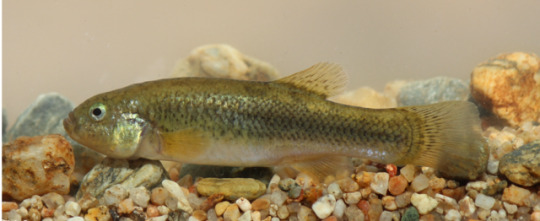
CIENTÍFICOS DESCUBREN UNA NUEVA ESPECIE DE PEZ QUE VIVE A MÁS DE 4000 M DE ALTURA
Vista por primera vez en 2009 por científicos chilenos en el rió Chancacolla, a 4.000 metros sobre el nivel del mar en el altiplano chileno a 120 km. hacia la cordillera desde Iquique, en la región de Tarapacá, la nueva especie de pez llamada Pseudorestias lirimensis es recientemente descrita. La nueva especie de pez es única en su tipo, mide alrededor de 7 centímetros, las hembras son el doble más grandes que los machos, y les superan en numero.

- El rio Chancacolla no supera los 50 cm de profundidad, y penas los 3 metros de ancho. El rio está expuesto mayormente a la radiación UV durante el día y a bajas temperaturas durante la noche.
La presencia de esta especie, única en su tipo, es interpretada por los científicos como el resultado de la insolación de su hábitat con las demás cuencas y ríos hace unos 20 millones de años atrás. Su baja población, junto a su reducido hábitat y limitada distribución hacen que esta nueva especie sea considerada seriamente como un candidato a ser una especie en condición critica de amenaza de extinción.
Referencia (Acceso abierto): Arratia et al., 2017. Morphological and taxonomic descriptions of a new genus and species of killifishes (Teleostei: Cyprinodontiformes) from the high Andes of northern Chile. PlosONE.
#chile#nueva especie#new species#not marine#Pseudorestias lirimensis#Cyprinodontiformes#Teleostei#high andes#sudamerica#south america#science#ciencia#sciblr#ciencia en español#ciencia en tumblr#scienceblr#iquique#tarapaca#biologia#freshwater
6 notes
·
View notes
Photo
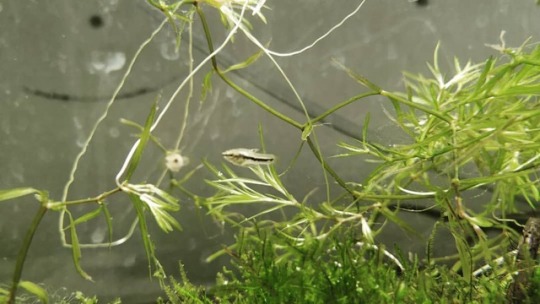
#cyprinodontiformes #livebearers #livebearer #northamerica #NANF #florida #heterandria #formosa #least #killifish #sarasota #canal #wildform #fish #aquarium #tank #led #sand #airfilter #fishroom #acquariotop (presso Sestri Ponente, Liguria, Italy) https://www.instagram.com/p/Bs5A8tRhD6o/?utm_source=ig_tumblr_share&igshid=rho7hy5pu1q0
#cyprinodontiformes#livebearers#livebearer#northamerica#nanf#florida#heterandria#formosa#least#killifish#sarasota#canal#wildform#fish#aquarium#tank#led#sand#airfilter#fishroom#acquariotop
0 notes
Note
Im setting up a very low end brackish tank and I have a particular interest in fish with interesting biological histories and adaptation. I'm mainly focused on golden wonder Killifish at the moment and I was wondering what your thoughts are on tankmates, I was thinking about stocking a few female Florida Flagfish and the killi(s) in a 40 paladarium with about 20 gallons of water
I typically don’t recommend more than one Killifish species per tank - defining that here as a member of the Cyprinodontiformes order. This includes the Killifishes, Topminnows, Splitfins, and Pupfish which all find their way into the trade on occasion. If you want the Golden Wonder Killie (a great choice) then that excludes others. But a few alternative options if you are inclined:
- The Mangrove Rivulus (Kryptolebias marmoratus) can survive for days out of water! They are pretty easy going with easy-going tankmates and a paludarium for Fiddlers and Guppies would be a fun tank.
- The Sheepshead Minnow (Cyprinodon variegatus) can tolerate up to 6 times the salinity of the ocean! They are pretty territorial, but if you offer lots of plastic plants and have females outnumber the males they should do okay in this tank if you increased it to 30 gallons of water.
- Looking for a hardy fish that can tolerate extremes? Look no further than Mosquitofish (Gambusia sp.) as they can survive water at subtropical temps up to 108F and salinity twice that of the ocean. They are invasive to many areas due to their wide range of tolerances and utility at eating nasty pond bugs. I wouldn’t mix them with other species though. [Not a Killifish but they are definitely masters of adaptation]
If you want to keep with the Wonder Killies, look into X-Ray Tetras (the only commercially available brackish tetras), Orange Chromides (from a genus of Indian Cichlids), Kribensis (which breed readily, but percentage of males/females in brood depend on pH), and Platies (which aren’t really unique, they just are nice fish which will work here). Knight Gobies are another choice.
Also consider Fiddler Crabs, they are fantastic tankmates in a peaceful, brackish paludarium. Though a few other brackish amphibious crustaceans exist in the trade - Red Clawed Crabs, Crayfish, Green Hermits, and sometimes other crab species - avoid them all as they are more likely to consume your fish.
Avoid too small fish, such as Bumblebee Gobies, Guppies (including “normal”, Endler’s, and Swamp), Blue-Eyes, and Dwarf Mosquitofish (only a distant relation to Gambusia) as they are food targets for large-ish Killies.
2 notes
·
View notes
Text
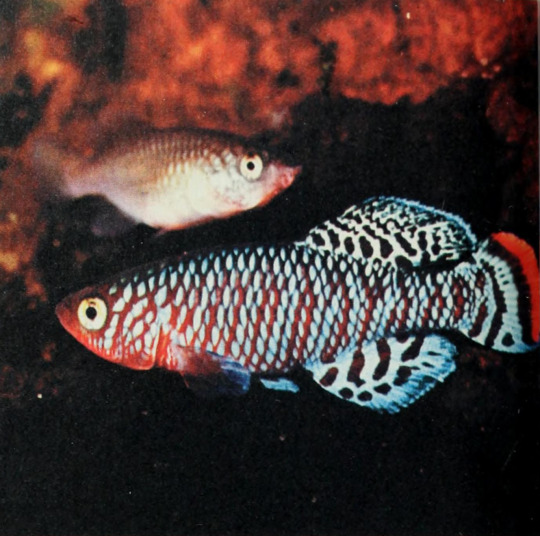
Killifish
By: Unknown photographer
From: Disney’s Wonderful World of Knowledge
1971
71 notes
·
View notes
Text
ICHTHYOFAUNAL DIVERSITY OF KINNERASANI RESERVOIR IN BHADRADRI KOTHAGUDEM DISTRICT OF TELANGANA, INDIA | UTTAR PRADESH JOURNAL OF ZOOLOGY
In this study, the Ichthyofaunal diversity of the Kinnerasani reservoir in Telangana state was discovered. Sixty-one fish species were discovered, divided into eight orders, 19 families, and 40 genera. The order Cypriniformes dominated with 24 species, accounting for 39.34% of all species, followed by Perciformes with 14 (22.95%), Siluriformes with 13 (21.31%), Channiformes with 04 (6.55%), Beloniformes and Anguilliformes with 02 (3.27%), Osteoglossiformes and Cyprinodontiformes with 01 species each (1.64 percent ). Perciformes supplied 06 (31.57 percent) of the 19 families listed, while Siluriformes gave 05. (26.31 percent ). The current communication presents fish species baseline data as well as diversity indexes and conservation status.
Please see the link :- http://mbimph.com/index.php/UPJOZ/article/view/2575
0 notes
Photo

This is the 230th installment of 'Since I've Been Gone'. Taken on 2021 4th March during my time with @americanconservationexperience, while at my work site, I noticed some fish trapped in between rocks and the side of the refuge floodgate. I managed to scoop two out and learned they were gulf killifish (Fundulus grandis). They are important in the gulf coast ecosystem to being a food source for many species. However, where they are really is for ecotoxicology studies, especially on the effects of oil spills. Luckily, weeks later, the floodgate was opened allowing the remaining fish to swim free. #animal #animals #wildlife #nature #aquaticlife #texaswildlife #texasnature #fish #fishes #fishy #fishies #fishies🐠 #texasfish #brackishwaterfish #killifish #killifishes #topminnow #topminnows #txwildlife #txnature #vertebrate #vertebrates #animalia #chordata #actinopterygii #cyprinodontiformes #fundulidae #fundulus #fundulusgrandis #gulfkillifish (at Laguna Atascosa National Wildlife Refuge) https://www.instagram.com/p/CYLA0sarO_Y/?utm_medium=tumblr
#animal#animals#wildlife#nature#aquaticlife#texaswildlife#texasnature#fish#fishes#fishy#fishies#fishies🐠#texasfish#brackishwaterfish#killifish#killifishes#topminnow#topminnows#txwildlife#txnature#vertebrate#vertebrates#animalia#chordata#actinopterygii#cyprinodontiformes#fundulidae#fundulus#fundulusgrandis#gulfkillifish
1 note
·
View note
Text

Fish that Band Together: Banded Killifish in the Home Aquarium
A close relative of the more widely known (and distributed) Mummichogs, the Banded Killifish is an interesting choice for keeping in the home aquarium - and a better choice than its’ relative for freshwater keeping. Below is some information you should consider before selecting one or more of these guys for your home tank.
Species
Fundulidae (Topminnows) is one of the 10 families in the order Cyprinodontiformes (Toothcarps) along with Poeciliidae (Livebearers), Cyprinodontidae (Pupfishes), Rivulidae (Rivulines, New World Killifish), and Aplocheilidae (Killifish). Fundulus is a relatively large genus of 39 fish, all with different care requirements. Therefore the focus of this discussion will be:
Fundulus diaphanus (Banded Killifish) [pictured]
As far as I know, these fish are not sold at all in the trade - save for maybe through specialist dealers. Likely if you want one, you’ll have to collect them yourself.
Conservation Status
The Banded Killifish has been evaluated as Least Concern by the IUCN.
Description
The Banded Killifish is an elongated fish that can attain a maximum size of about 5 inches, though you’d be lucky to find one much above 3.5 inches. Males have a more prominent banding pattern on their sides and when in breeding condition gain a blueish iridescence. Females have a more subdued banding pattern with thinner bars; sometimes these aren’t overtly present at all. As with other Killifish, they do appear to have regional “variants” depending on where they are caught. The ones pictured were captured in Virginia.
Common for Topminnows, Banded Killifish are more territorial than aggressive on average. They will push other fish out of their turf but don’t typically continue to chase tankmates once they have fled. They can be tough on fish that don’t learn to stay out, though, such as some of the daces that swim all over the tank. They are more likely to leave fish alone that live on the bottom of the tank like darters and madtoms.
The best tankmates are either a) bottom feeders, or b) boisterous fish that can take care of themselves. Mudminnows, Darters, Madtoms, Mosquitofish, other Killifish, Fathead Minnows, and maybe Sticklebacks are all fair choices. In a brackish setting, consider Rivulines, native Gobies, Hogchokers, and maybe the smaller Sleeper Gobies.
As the name implies, these fish mostly inhabit the top of the tank, searching for floating morsels to eat. Their pattern makes them adept hiders and in a planted tank you may see them often lurking among the plants.
Feeding
I’ve found Banded Killifish to be very easy to feed. Dried Foods (flakes and pellets), frozen foods (brine shrimp, mysis shrimp, bloodworms, “marine” mixes), and live foods are all relished. They take to prepared foods right away - they push to be at the front of the chow line no matter what you feed.
Water Quality
Banded Killifish are best kept around room temperature (66-70 F), though can handle periods of much warmer or slightly cooler. They do best in basic, hard water - between 7.0 and 8.0 pH and 10-20 dH. They are more likely to inhabit smaller tributaries and marshes than fast moving streams, so ensure your tank turnover isn’t tumultuous.
Brackish Suitability
Banded Killifish thrive in brackish conditions. Laboratory tests showed they adapt well up to 1.010 and anecdotal evidence suggests they can live in full strength sea-water (1.025). That said, they strongly prefer freshwater - every specimen I’ve caught has been in totally freshwater conditions.
Tank Size
29 gallons is the starting point I’d use for a singleton with tankmates - if looking to add other killifish of the same species (or related) then I’d start at 55 gallons to allow all the space to coexist peacefully.
Breeding
Banded Killifish spawn during the summer, which can be replicated by increasing the temperature in the tank to 72-75 F. Eggs are deposited on algae or other filamentous media (like spawning mops used for other killifish) and hatch in 10-12 days. There is no parental care following hatching and fry may be consumed by the parents at this time.
Banded Killifish can interbreed with Mummichogs (and maybe other Fundulus Killifish). Keep this in mind if you keep them together.
Final Thoughts
Boisterous for sure, Banded Killifish are also easy to care for, very hardy, and not overly aggressive. In breeding colors, they are also quite attractive. I recommend them highly for home keeping.
Sources
Assessment and Status Report on the Banded Killifish, COSEWIC
Evolutionary variation in salinity tolerance among species of killifishes (Fundulus spp.), Jonah, Lauren Shea
(Image Source)
9 notes
·
View notes